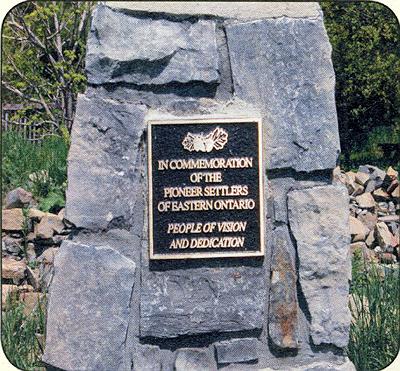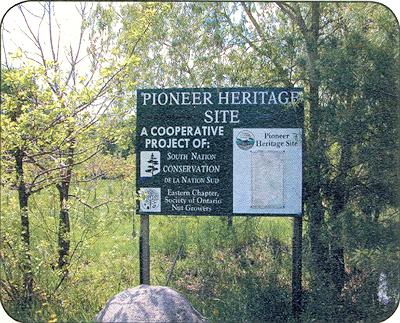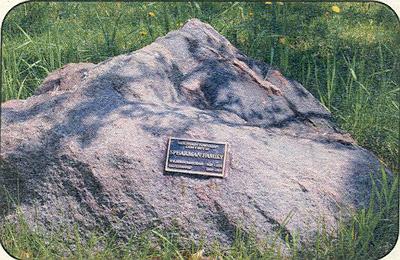Oak Valley Pioneer Park
Historical Perspective
| |
|
Early History
Nine thousand years ago, the lands of eastern Ontario emerged from the glacial waters of the
Champlain Sea. The sea drained away to the Atlantic and the water flow switched from the
Ottawa River Valley to the Great Lakes and the St. Lawrence Valley. Eastern Ontario began its
modern history.
Plants, birds and animals invaded the old sea floor. Tundra type plants spread from the beaches
and small islands that dotted the sea. The aboriginal people moved onto the large clay flats and
gravel ridges. The South Nation River drained the valleys.
As the climate warmed and coniferous trees, shrubs and plants invaded the seabed bringing with
them animal and freshwater life. Over the next millennia deciduous trees, the hardwoods arrived.
Two thousand years ago the climate and environment were similar to today. The river was
already aged, with numerous oxbows and wetlands where layers of peat had been laid down. The
land, air and water supported a wide range of plants, animals, fish and birds.
The aboriginal population was also growing. They were hunters and gatherers who developed
tools and utensils using stone, wood, and bone. Clays were used to make pottery.They also
imported shell, copper and skills.
Arrival of Agriculture
One thousand years ago the native peoples, south west of Chesterville, began to grow corn,
beans, squash, sunflower, artichokes and tobacco. Their crops supported settled communities and
trade with neighbours.
The St. Lawrence Iroquois, lived in communities of up to 3000 people. It was a matriarchal
society led by clan mothers and about 12 families lived in each longhouse. The houses were
protected by a log palisade. One such site is located east of Oak Valley.
They located their villages by water, next to wetlands and large fields. The former provided fish,
shell fish, plants and some security. The forests and meadows provided deer and other animals
plus plants, wood, nuts and fruits. The fields were cleared and planted in crops. The residents
lived a relatively comfortable life with a diverse diet.
About 1550, the St Lawrence Iroquois died out, probably from European diseases. Farming
ended at Oak Valley for 200 years.
The Early Settlement of Oak Valley
 After 1783, the United Empire Loyalists, Americans of English, Scots, Irish, German (Hessian)
and Palatine origins, settled on the St Lawrence Front. Succeeding generations spread inland.
Initial land grants made to UEL families were often sold to American, and British settlers after
1800.
After 1783, the United Empire Loyalists, Americans of English, Scots, Irish, German (Hessian)
and Palatine origins, settled on the St Lawrence Front. Succeeding generations spread inland.
Initial land grants made to UEL families were often sold to American, and British settlers after
1800.
Mountain Township was surveyed about 1793 and named for Bishop Jacob Mountain. Several
nearby lots were reserved for the established church and Kings College. Early settlers included
the Hyndman, Bigford, Armstrong and Baldwin families.
Benjamin Bigford left Upper New York State about 1797, probably spending time in Leeds and
Grenville before settling in Dundas County. In 1814 he purchased Lot 18, Concession 1,
Mountain Township. It was located on the flood plain of the north and south branches of the
South (or Petite) Nation River.
The area was successively named the Forks, the Bigford Settlement and Oak Valley, (for the oak
and hardwood stands).
He married Margaret Fralick, daughter of a Loyalist family from South Carolina. The family
probably arrived at Oak Valley by boat, landing in the Oxbow. They raised a family of eleven to
adulthood.
The Bigford family built a home, and sheds, planted grain and crops, fenced land for pasture,
cut brush and girdled trees, burned trees and brush, helped build the 'forced road' along the
river, used oxen to plough and haul goods, crops, worked with oxen and horses to cultivate,
and hunted and fished for essential settler foods.
Pioneer families were isolated. Roads to South Mountain and Inkerman were obstructed by the
wetlands, creek crossings and unoccupied church and educational "reserve" lands. In time, the
Brinston Road was built direct to the St Lawrence, and another to Kemptville and the Rideau
Canal works.
 By 1851, the Bigfords were fairly affluent. They lived out their lives in their log home assisted by
hired hands. Several sons and daughters were farming nearby and living in frame houses.
By 1851, the Bigfords were fairly affluent. They lived out their lives in their log home assisted by
hired hands. Several sons and daughters were farming nearby and living in frame houses.
The farm had twenty one acres in wheat, oats, corn, and potatoes. Nineteen acres were in pasture
and feed for cattle, sheep, horses and pigs. Sixty acres remained in woods.
Home output included 60 pounds of wool, 25 yards of fulled cloth, and 30 yards of flannel. They
also produced 200 pounds of butter, some cheese, and several barrels of pork.
The SD&G Historical Atlas, published soon after Benjamin's death shows parts of the family
parcel occupied by the estate of John, and Benjamin, and John C. Bigford. William Bigford lived
on lot 19.
By 1890 the farm economy had changed. Milk was the major product for industrial processing
into fresh milk, cheese and butter.
The land was cleared of trees. Corn became the major field crop and farm machinery increased
productivity. Larger barns and silos were built to shelter and feed growing herds. The new
railway line provided for rapid movement of people, produce and goods between farm and
industrial centres such as Montreal, Cornwall and Ottawa.
The farm changes produced annual floods when rapid snow melt and summer storms could not
be absorbed by the land and ran off into the slow meandering river channel. The flooding was
increased as farmers created farm drains to speed field drainage.
The Bigford (Bickford) family occupied the Oak Valley farm for over a century. At least twelve
Bigfords and Fralicks are buried on the farm. They are commemorated by a pioneer memorial
plaque at the Oak Valley Pioneer Park.
Over time many of the Bigford family dispersed. Though the name is no longer common, there
are many Bigford descendants in the area.
Oak Valley today
 South Nation Conservation owns part of lot 18, the Oak Valley Pioneer Park lands. The
Authority was created in 1947 to promote river flow and mitigate seasonal flooding.
South Nation Conservation owns part of lot 18, the Oak Valley Pioneer Park lands. The
Authority was created in 1947 to promote river flow and mitigate seasonal flooding.
In the 1970's river channelization reached Oak Valley. Large oxbows were cut off and filled,
exposing the underlying multi-million year old bedrock which can be seen at low water. Today
South Nation Conservation is a leader in environmental programs and promotion of a healthy
ecosystem.
Following channelization, an orphan parcel remained at Oak Valley. Not useful to local farmers
it was littered with derelict farm buildings.
Irene Woolford Broad saw an opportunity to use a parcel for community purposes and planted
trees. As in settlement days, volunteer efforts improved the Oak Valley site and created a
community asset.
Provided by the Volunteers of Oak Valley Pioneer Park. Feel free to copy with a credit.
 After 1783, the United Empire Loyalists, Americans of English, Scots, Irish, German (Hessian)
and Palatine origins, settled on the St Lawrence Front. Succeeding generations spread inland.
Initial land grants made to UEL families were often sold to American, and British settlers after
1800.
After 1783, the United Empire Loyalists, Americans of English, Scots, Irish, German (Hessian)
and Palatine origins, settled on the St Lawrence Front. Succeeding generations spread inland.
Initial land grants made to UEL families were often sold to American, and British settlers after
1800.
 By 1851, the Bigfords were fairly affluent. They lived out their lives in their log home assisted by
hired hands. Several sons and daughters were farming nearby and living in frame houses.
By 1851, the Bigfords were fairly affluent. They lived out their lives in their log home assisted by
hired hands. Several sons and daughters were farming nearby and living in frame houses.
 South Nation Conservation owns part of lot 18, the Oak Valley Pioneer Park lands. The
Authority was created in 1947 to promote river flow and mitigate seasonal flooding.
South Nation Conservation owns part of lot 18, the Oak Valley Pioneer Park lands. The
Authority was created in 1947 to promote river flow and mitigate seasonal flooding.